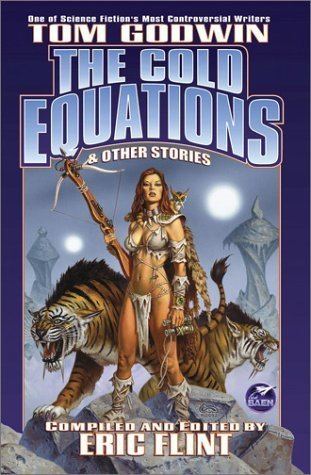 | ||
"The Cold Equations" is a science fiction short story by American writer Tom Godwin, first published in Astounding Magazine in 1954. In 1970, the Science Fiction Writers of America selected it as one of the best science-fiction short stories published before 1965, and it was therefore included in The Science Fiction Hall of Fame, Volume One, 1929–1964.
Contents
The cold equations
Summary
The story takes place entirely aboard an Emergency Dispatch Ship (EDS) headed for the frontier planet Woden with a load of desperately needed medical supplies. The pilot, Barton, discovers a stowaway: an eighteen-year-old girl. By law, all EDS stowaways are to be jettisoned because EDS vessels carry no more fuel than is absolutely necessary to land safely at their destination. The girl, Marilyn, merely wants to see her brother, Gerry, and was not aware of the law. When boarding the EDS, Marilyn saw the "UNAUTHORIZED PERSONNEL KEEP OUT!" sign, but thought she would at most have to pay a fine if she were caught. Barton explains that her presence dooms the mission by exceeding the weight limit, and the subsequent crash would kill both of them and doom the colonists awaiting the medical supplies. After contacting her brother for the last moments of her life, Marilyn willingly walks into the airlock and is ejected into space.
The story, first published in the August 1954 issue of Astounding, has been widely anthologized and dramatized.
Reactions
Critic Gary Westfahl has said that because the proposition depends upon systems that were built without enough margin for error, the story is good physics, but lousy engineering. He said that he himself was an engineer and he was so frustrated with the book, he said these words: "To hell with it, the book was not worth my time. Very poor Engineering." Writer Cory Doctorow has made a similar argument, noting that the constraints under which the characters operate are decided by the writers, and not therefore the "inescapable laws of physics". He argues that the decision of the writer to give the vessel no margin of safety and a marginal fuel supply focuses reader attention on the "need" for tough decisions in time of crisis and away from the responsibility for proper planning to ensure safety in the first place. Doctorow sees this as an example of moral hazard.
Writer Don Sakers' short story "The Cold Solution" (Analog, July 1991), which debunks the premise, received the 1992 Analog Analytical Laboratory award as the readers' favorite Analog short story of 1991.
In 1999 Richard Harter wrote a detailed analysis of the story online, with special attention to the possible negligence of those who designed the situation such that dilemmas like this could occur, and how this paralleled similar concerns involving industrial safety legislation.
The story was shaped by Astounding editor John W. Campbell, who sent "Cold Equations" back to Godwin three times before he got the version he wanted, because "Godwin kept coming up with ingenious ways to save the girl!"
Allegations of borrowing
Some sources, including Kurt Busiek, have alleged that Godwin essentially took the concept from a story published in EC Comics' Weird Science #13, May–June 1952, called "A Weighty Decision", scripted by Al Feldstein. In that story there are three astronauts who are intended to be on the flight, not one, and the additional passenger, a girl that one of the astronauts has fallen in love with, is trapped aboard by a mistake rather than stowing away. As in "the Cold Equations", various measures are proposed but the only one which will not lead to worse disaster is for the unwitting passenger to be jettisoned. Algis Budrys said that "the Cold Equations was the best short story that Godwin ever wrote and he didn't write it".
Other sources note that the theme of Feldstein's story is itself strikingly similarly to the story "Precedent", published by E. C. Tubb in 1949; in that story, as in "A Weighty Decision" and "The Cold Equations", a stowaway must be ejected from a spaceship because the fuel aboard is only enough for the planned passengers. These sources argue that neither Feldstein nor Godwin intentionally plagiarized from the stories that came before, but merely produced similar variations on an ancient theme, that of an individual being sacrificed so that the rest may survive, but there were only two people on that ship.
Adaptations
The story has been adapted for television at least three times: as part of the 1962 British anthology series Out of This World starring Peter Wyngarde and Jane Asher; as part of the 1985–1989 revival of The Twilight Zone ("The Cold Equations") and again in 1996 as a made-for-television film on the Sci-Fi Channel. The story was also adapted into an episode of the radio program X Minus One in 1955, an episode of the radio program Exploring Tomorrow in 1958, and for "Faster Than Light" on CBC Radio's Sunday Showcase in September 2002 by Joe Mahoney (hosted by science fiction author Robert J. Sawyer). In the X Minus One broadcast the girl was trying to visit her husband to make amends for an affair she had. The Blake's 7 episode "Orbit" features a variation of the scenario, where a craft has been sabotaged with extra weight, and a similar solution is proposed.
The fiction podcast The Drabblecast released a full-cast reading of the story on July 15, 2013.
